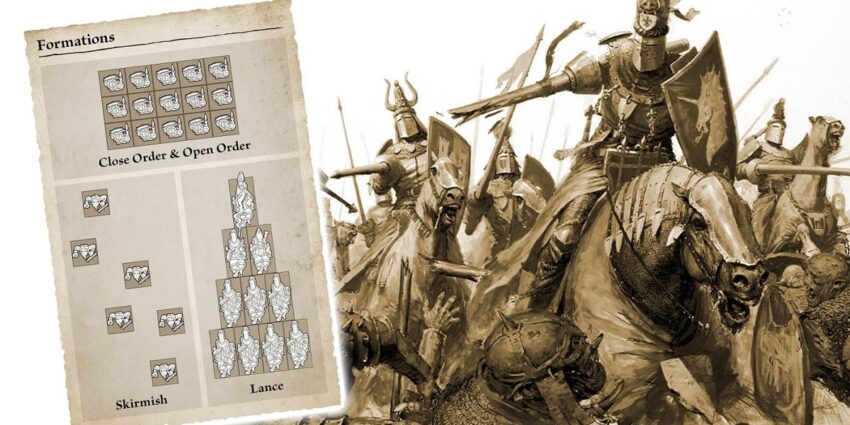Let’s take a look at movement through all the editions of Warhammer Fantasy and how they compare to what we know about The Old World.
Last week we looked at the Strategy Phase and it’s humble beginnings in previous editions of Warhammer Fantasy. In this week’s edition of highly dubious quotes from the Old World Almanack: “It’s now time to investigate one of the major mechanics that differentiates this game from any other Warhammer game: its movement system.” Let’s do it!
But first let’s take a quick look at formations, since they are discussed briefly in this article. Warhammer is built upon formations, making it a mass battle, rank and flank game. The entire reason for it’s existence is because Citadel realized people were buying large numbers of their D&D minis and playing ad hoc battle games with them, so they thought they would codify rules for such a system. First edition has the standard fare of square bases ranked up and skirmish formation. 3rd Edition, widely regarded as the most complex when it comes to formations and movement, has an entire page of dense text on single file formations. 4th Edition tries to tamp this down with Fast Cavalry and Snaking. 5th Edition gave us the Lance and Arrowhead formations, and there were no major innovations after that. The Old World has these classics, while differentiating between Combat Order and Marching Column (where a unit is wider than it is deep and vise versa, respectively) and Open vs Close Order, which both appear to be permutations of Combat Order.
The Movement Phase in The Old World, like all the others, is arbitrarily broken down into exactly four sub-phases: Declare Charges, Charge Moves, Compulsory Moves and Remaining Moves. Early editions of Warhammer did no such thing. From first through third edition a player could move and charge in whatever order they wished. It isn’t until 4th Edition where we get a sub-phase structure: Declare Charges, Rally Fleeing Troops, Compulsory Moves, Move Chargers and Remaining Moves. This exact structure survives until 8th Edition, when the two charge steps are combined and take place before everything else.
In The Old World a player will declare all their charges to start the movement phase, and then the non-active player will declare charge reactions, which is the way it worked in 6th and 7th Editions. In 8th Ed players declared charges and resolved reactions until no more charges were declared, then moved all the chargers. (Special note: you are allowed to premeasure in The Old World, which I have seen some people declaring a huge change, but you were allowed to premeasure in 8th Ed, so I don’t know what they are talking about) Before 6th Edition, reactions were simply declared at the same time as charges. Hold, Flee and Stand and Shoot have been the standard reactions since 1st Edition, though that edition also had a 4th option: the Countercharge! The Old world brings back this blast from the past.
The next sub-phase in The Old World is to make your charge moves (and presumably to resolve any charge reactions?) Where previously a player would Rally Fleeing Troops and make Compulsory Moves, The Old World skips ahead to the good stuff. In 1st through 7th Edition a charge move was simply double a unit’s movement value, while also accounting for terrain and special rules. In 8th Edition a player rolled 2D6 and added that to the unit’s movement value, making charges wildly unpredictable. The Old World has taken the more reasonable approach of allowing the player to roll 2D6 and add the higher result to their movement. (Fun fact: this is the formally from 8th Edition for how far to move a unit that fails a charge). The last item of note is that wheeling a unit in order to charge another one counts as part of the charge move, which is how it has always been, except in 8th where units got a free wheel move of up to 90 degrees. Why this was taken away I don’t know, but tournament players are grumpy and I’m fine with that.
Once Chargers have moved it’s time for Compulsory Moves, such as moving units that failed their stupidity tests or did not rally at the start of the turn. Compulsory moves have been around since 4th Edition, before which they simply occurred at the start of the turn or whenever the particular test was failed. After compulsory moves come Remaining Moves, which is a rather pedestrian title for the most common type of movement in the game.
Let’s look briefly at how units move. They may wheel, which has been around since the dawn of Warhammer, pivoting on one of its front corners and measuring the distance moved from the other. They may turn in place, sacrificing a quarter of their movement for each 90 degrees they turned. They may move backwards or sideways at half their move speed, and redress and reform. These maneuvers were part of 8th Edition, but before that they were all understood to be part of the turn function listed above. Moving sideways at half speed is the same as spending a quarter of your move to to turn, moving half moving two quarters of your move in that direction, then spending your last quarter move to turn forward again. Getting to move backwards at half speed is a bargain, however.
Ok, I should probably stop there, this was a lot. Join me next week when I take a look at shooting and our first chart! Until then, happy hobbying!
And remember, Frontline Gaming sells gaming products at a discount, every day in their webcart!





